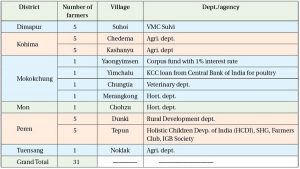Nagaland
Only 7% of farmers receive seeds from govt. departments, study reports

Eastern Mirror Desk
Dimapur, Aug. 1: The directorate of Evaluation’s report on “marketing facilities for agriculture and allied products in Nagaland” reports that there is a complete lack of marketing infrastructure in the rural areas and that there is wastage of large quantities of agricultural produce.
The wastage is from being unsold due to unavailability of access to markets. Besides, there is no processing and packaging unit in the rural areas unlike in the urban areas, the study says.
The report also mentioned that there were no storage facilities in the villages to store agricultural produce, an important component of agriculture marketing system that acts as a link between the producer and the buyer.
The reference period of the study was 2013-14, 2014-15 and 2015-16 and the field survey for the collection of data was carried out in the month of November and December 2016.
The Nagaland State Agriculture Marketing Board (NSAMB) and the Agriculture Produce Marketing Committee (APMC) in Nagaland has minimal infrastructure to facilitate marketing agricultural produce.
The NSAMB at Dimapur and the APMCs of Mokokchung, Phek, Tuensang and Jalukie in Peren district were reported to have functional warehouses.
The APMC in Tuensang, Kohima and Niuland have marketing sheds for the sale of agricultural produce. Tuensang and Mokokchung APMC have a weight bridge but all these facilities have remained underutilised when it comes to the development of agricultural marketing, the report maintained.
Marketing linkages
Access to marketing opportunities is vital for the growth of rural economy. It has been observed that most farmers have no access to marketing facilities and they are ignorant of the values of agricultural products in the market. It was found that most of the farmers sell their products to traders within the village itself, this percentage being 45.5%. Farmers who sell directly to the consumer was only 19.11%.
Agriculture credit
Agriculture credit is crucial for the growth and development of agricultural sector. There are two sources of credits for farmers, both institutional and non-institutional. Institutional sources include commercial banks, regional rural banks (RRB), and micro financial institutions (MFIs) and the government. The non-institutional sources are money lenders and relatives.
According to the report, only 2.9% of farmers have obtained financial credits from the govt., banks and other agencies which clearly indicated a very minimal reach of agriculture credit to farmers (See table).
Most of the farmers reportedly use only locally available traditional seeds (72%) while some farmers receive seeds from the govt. departments (7%). It was also found that 20% of the farmers purchase seeds from the open market.
The report stated that road transportation is the only means of transportation of agricultural produce to markets. The study found that the road network connecting especially the villages and agricultural fields was completely deplorable.
Moreover, there were no transportation facilities for farmers as well as traders to bring agricultural produce to the market.
In its study, the Evaluation dept. has suggested that agriculture warehouses should be constructed, based on scientific method for storage and preservation of agriculture and allied products, at various strategic locations along with storage facilities at the village level.
Unused marketing sheds
Also, a viable market location should be identified for agricultural marketing as the numerous marketing sheds along highways and villages remain unutilised by farmers and traders as there are no buyers.
On the policy, it suggested that the basic functions and structure of the APMC needs to be revamped so as to adapt to changing economic scenarios; agriculture marketing development authority should be established at the village level to exploit the full potential and resources of the local areas depending on their availability.
It observed that regulation and sensitisation of pricing system of agricultural goods was necessary for the growth of the rural economy. Further, guidelines for implementation of Minimum Support Price should be formulated taking into account the scenario of the agriculture sector in the state.
Again, the study suggested that agriculture-link roads to major agricultural zones may be constructed and maintained, and encourage provision of logistic support to farmers/producers so as to transport agricultural produce to the market by private sector or in Public Private Partnership mode.
The farmers should be given contract farming facilities as it will lead to an increase in agricultural production and ensure secure income source to the farmers, it stated.

